Creating a Google Cloud Services Connection for an MVE with Fortinet SD-WAN
You can create a network connection from an MVE (a FortiGate) to Google Cloud through Partner Interconnect.
When connecting to Google Cloud Platform (GCP) through Partner Interconnect with Megaport, the Virtual Cross Connect (VXC) forms the Layer 2 component of the connection and Layer 3 BGP is established directly between the customer and GCP.
Important
Before you begin, create an MVE (FortiGate) in FortiManager. For more information, see Creating an MVE. The MVE needs to be in the active state.
There are three parts to adding a Google Cloud connection to your MVE and FortiManager.
-
Create a Partner Interconnect attachment in Google Cloud Console or gcloud CLI. Copy the pairing key that is provided as part of the attachment creation. For additional details, see the Google documentation on Google Partner Interconnects.
-
In the Megaport Portal, create a VXC from your MVE to connect to your Google Cloud attachment.
-
In FortiManager, create a new interface and add the details of the Google Cloud connection.
These instructions step through the second and third parts.
Note
MVE for Fortinet SD-WAN requires configuration steps in both FortiManager and the Megaport Portal for all cloud connections.
Adding the Google Cloud connection in the Megaport Portal
To set up the GCP connection, you need to create the connection in the Megaport Portal.
To deploy a VXC to Google Cloud Platform from the Megaport Portal
-
In the Megaport Portal, click +Connection on the MVE to create your VXC.

-
Click the Cloud tile.
-
Select Google as the provider.
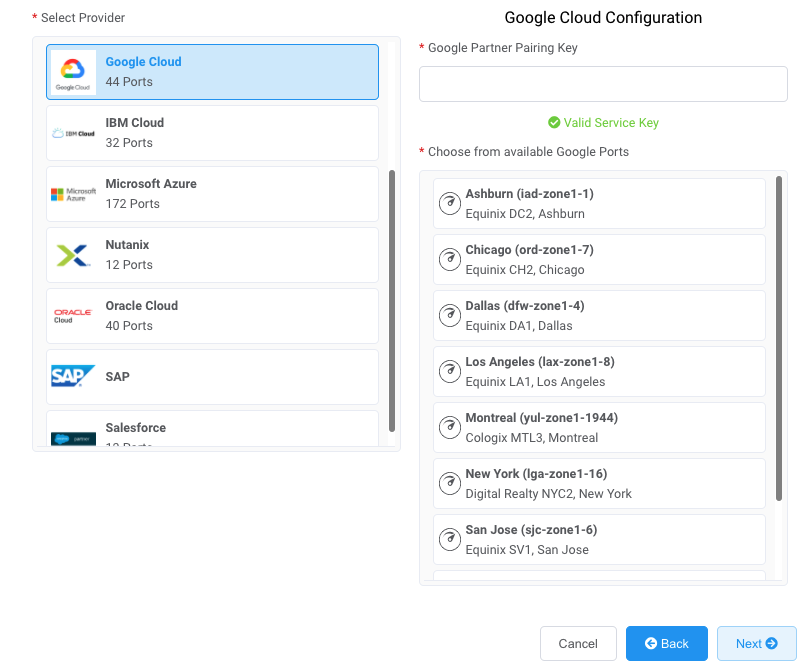
-
Copy and paste the pairing key from the Google Cloud console into the field in the right pane.
The relevant Google targets appear based on the region of your GCI Partner connection. - Select the target location for your connection and click Next.
-
Specify the connection details:
-
Connection Name – The name of your VXC to be shown in the Megaport Portal.
-
Service Level Reference (optional) – Specify a unique identifying number for your Megaport service to be used for billing purposes, such as a cost center number, unique customer ID, or purchase order number. The service level reference number appears for each service under the Product section of the invoice. You can also edit this field for an existing service.
-
Rate Limit – The speed of your connection in Mbps. Enter the same rate you selected for your Google port speed.
-
VXC State – Select Enabled or Shut Down to define the initial state of the connection. For more information, see Shutting Down a VXC for Failover Testing.
Note
If you select Shut Down, traffic will not flow through this service and it will behave as if it was down on the Megaport network. Billing for this service will remain active and you will still be charged for this connection.
-
A-End vNIC – Select an A-End vNIC from the drop-down list. For more information about vNICs, see Creating an MVE in the Megaport Portal.
-
Preferred A-End VLAN – The VLAN for this connection that you will receive through the MVE. This must be a unique VLAN ID on this MVE and can range from 2 to 4093. If you specify a VLAN ID that is already in use, the system displays the next available VLAN number. The VLAN ID must be unique to proceed with the order. If you don’t specify a value, Megaport will assign one.
-
Minimum Term – Select No Minimum Term, 12 Months, 24 Months, or 36 Months. Longer terms result in a lower monthly rate. 12 Months is selected by default. Take note of the information on the screen to avoid early termination fees (ETF).
Enable the Minimum Term Renewal option for services with a 12, 24, or 36-month term to automatically renew the contract at the same discounted price and term length at the end of the contract. If you don’t renew the contract, at the end of the term, the contract will automatically roll over to month-to-month contract for the following billing period, at the same price, without term discounts.
For more information, see VXC Pricing and Contract Terms and VXC, Megaport Internet, and IX Billing.
-
Resource Tags – You can use resource tags to add your own reference metadata to a Megaport service.
To add a tag:- Click Add Tags.
- Click Add New Tag.
- Enter details into the fields:
- Key – string maximum length 128. Valid values are a-z 0-9 _ : . / \ -
- Value – string maximum length 256. Valid values are a-z A-Z 0-9 _ : . @ / + \ - (space)
- Click Save.
If you already have resource tags for that service, you can manage them by clicking Manage Tags.
Warning
Never include sensitive information in a resource tag. Sensitive information includes commands that return existing tag definitions and information that will identify a person or company.
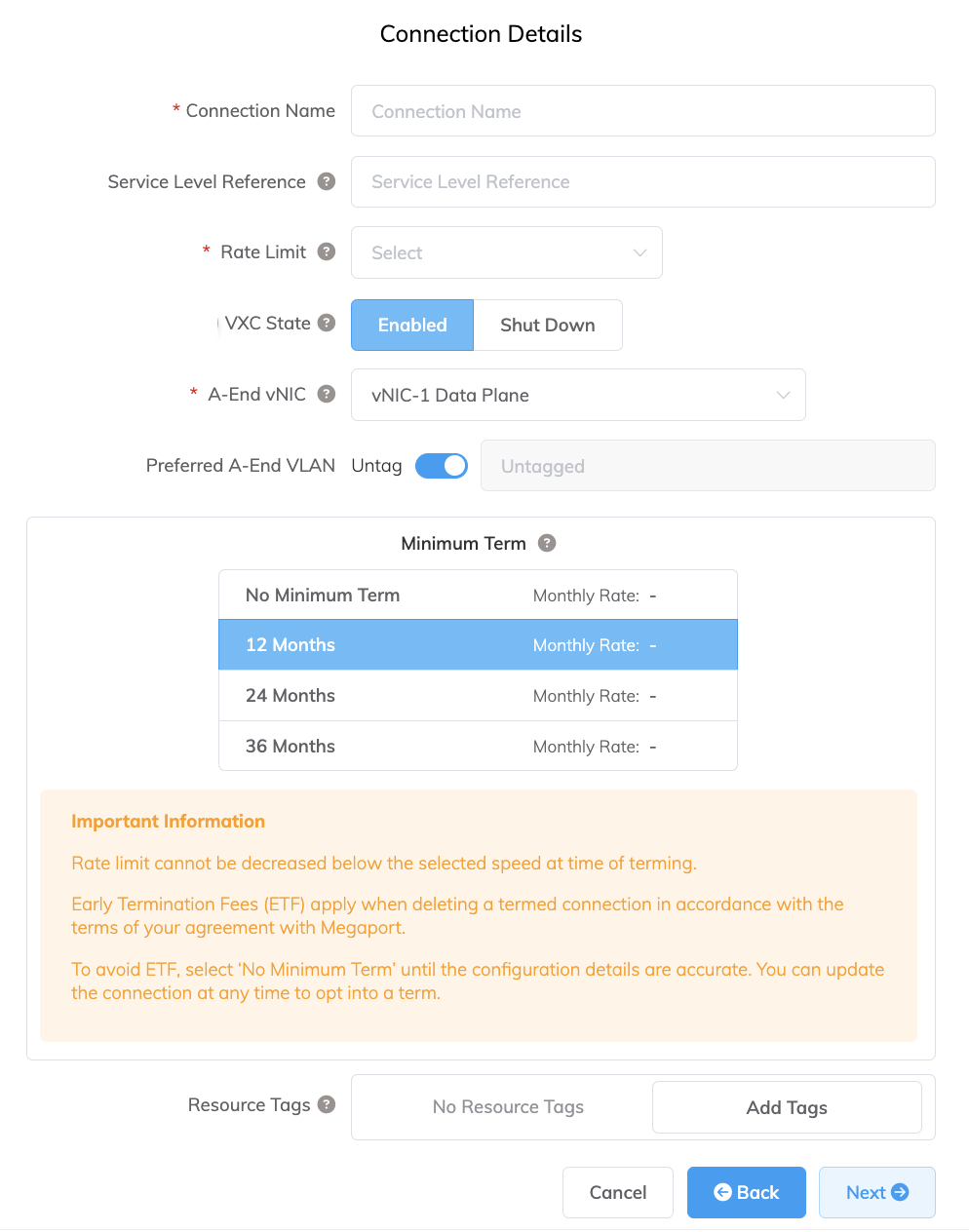
-
-
Add the VXC to your order and complete the checkout process.
-
Once you have deployed the VXC, go back to your attachment in the Google Cloud Console and accept the attachment.
You will be provided your private IP address from Google to configure BGP.
Ensure that you pre-activate the attachment or mark the attachment as active after configuring the VXC. Otherwise, you cannot set up BGP with your SD-WAN instance.
Note
The Google ASN will always be 16550.
Adding the Google Cloud connection to FortiManager
After you create the connection from your MVE to Google Cloud and set up the connection in the Google console, you need to configure it in FortiManager. This involves configuring BGP settings, ASNs, and VLANs.
To add the Google Cloud connection in FortiManager
-
Collect the connection details from the Google console.
Display the details of the connection you created in Google Cloud for this connection. Note the values for the Peer ASN, Cloud Router BGP IP, and BGP Peer ID.
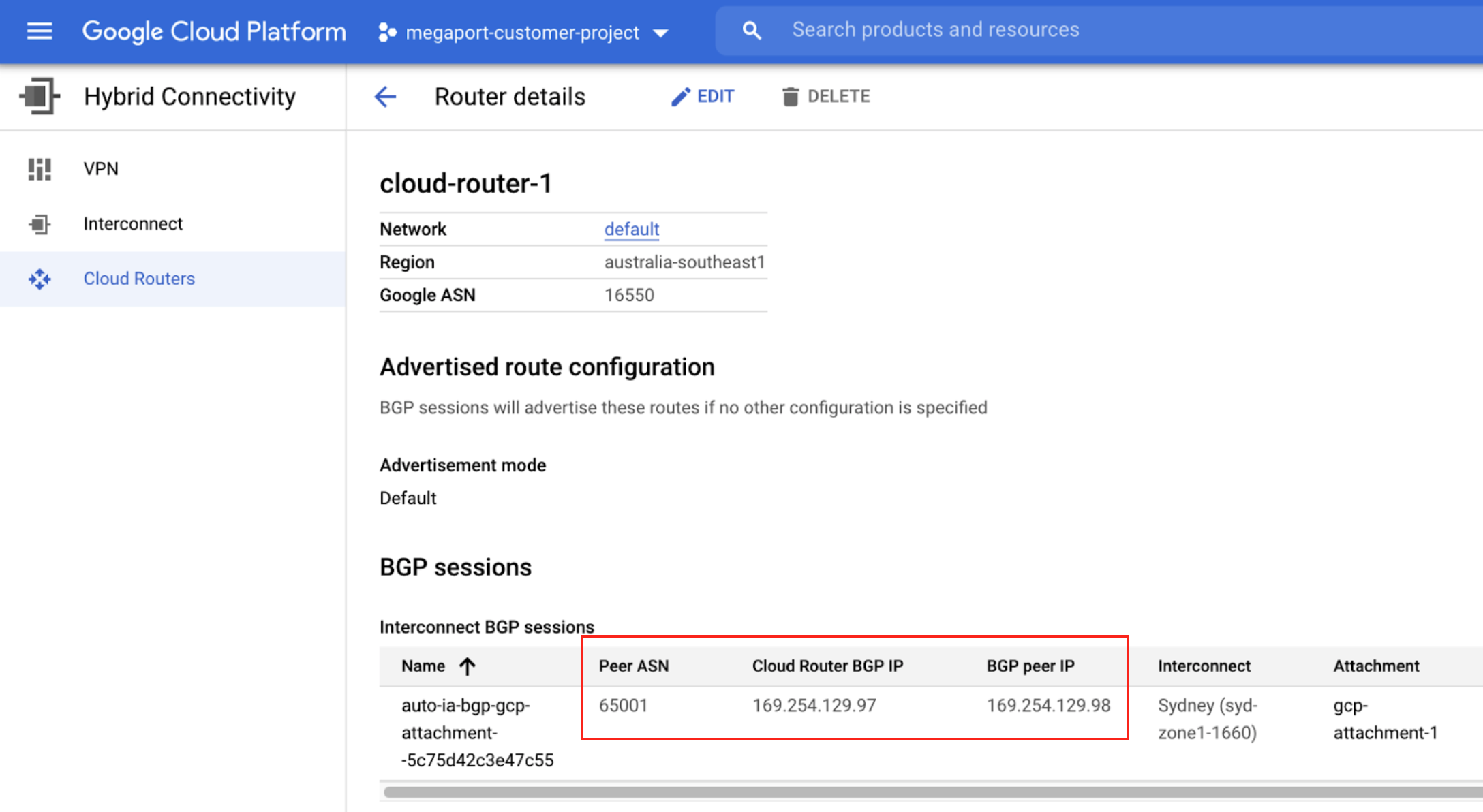
-
Collect the connection details from the Megaport Portal.
Click the gear icon for the Google connection from your MVE and click the Details view. Note the value for the A-End VLAN. -
Log in to the FortiManager.
Note
You can also log in on your MVE instance: https://<mve-ip-address>
-
From your managed device, go to the System menu and choose Interface.
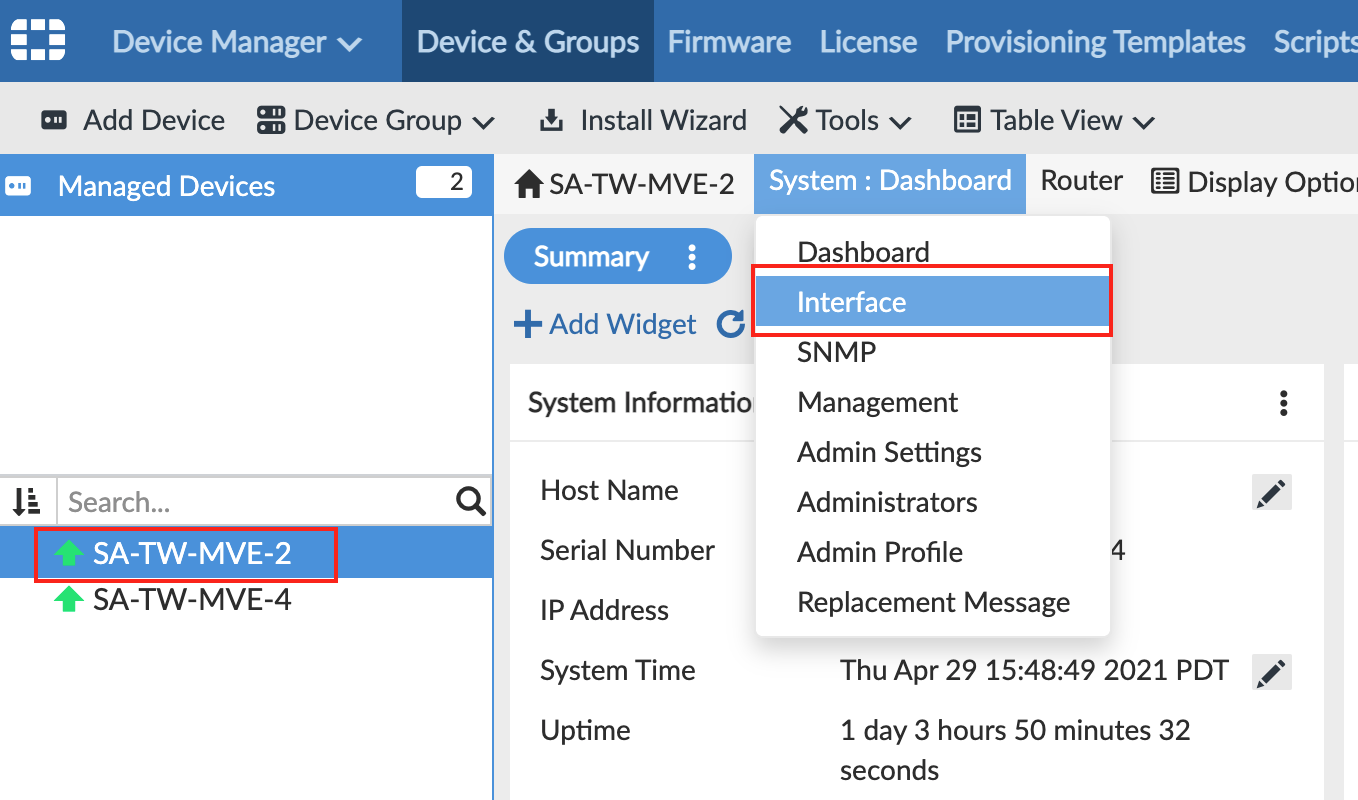
The page displays port1 as your physical interface. -
Click +Create New > Interface and provide this information:
- Interface Name – Specify a meaningful name for the interface.
- Alias Name (optional) – Enter an alternate name.
- Type – Choose VLAN.
- Interface – Choose the parent interface:
port1. - VLAN ID – Specify the A-End VLAN listed for this Google Connection in the Megaport Portal.
- Role – Choose Undefined.
- Addressing Mode – Select Manual.
- IP/Netmask – These values are available in the VLAN attachment details in the Google Cloud console. The IP address appears in the BGP Peer IP field.
- Administrative Access - Specify how you want to access this interface, such as HTTPS, PING, and SSH.
- DHCP Server - Click OFF.
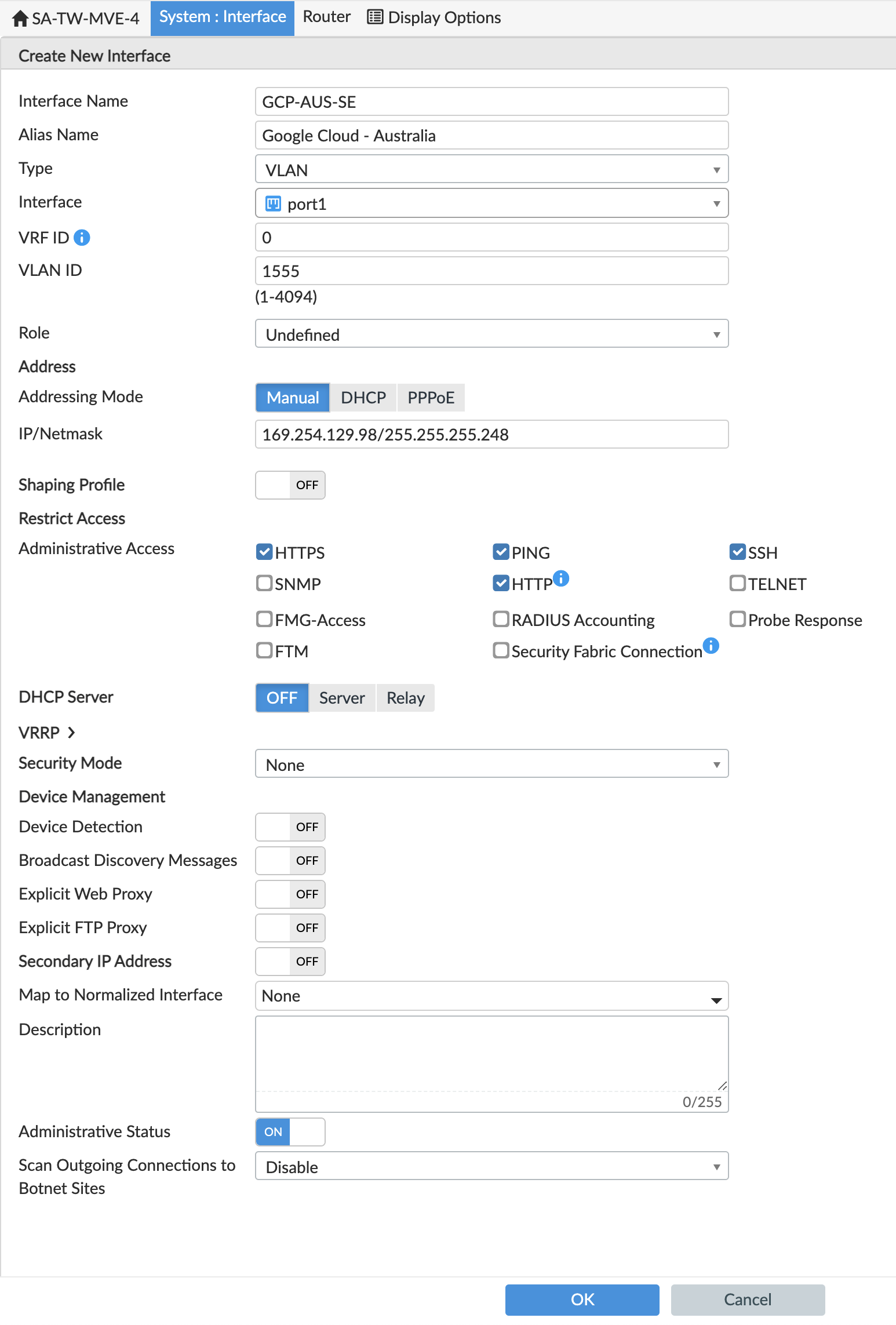
-
Click OK.
The new VLAN interface appears with yourport1physical interface.
You can run an execute ping command from FortiOS to verify the connection.
Note
You need to push the configuration to the MVE, which happens when you have AutoUpdate configured. If you cannot successfully ping the connection, go to Manage Devices in FortiManager, select the MVE, and choose Refresh Device from the More menu. If prompted, select AutoUpdate for the Config Status.
At this point, we have created the interface and next we need to create the BGP session.
-
In FortiManager, go to Router > BGP.
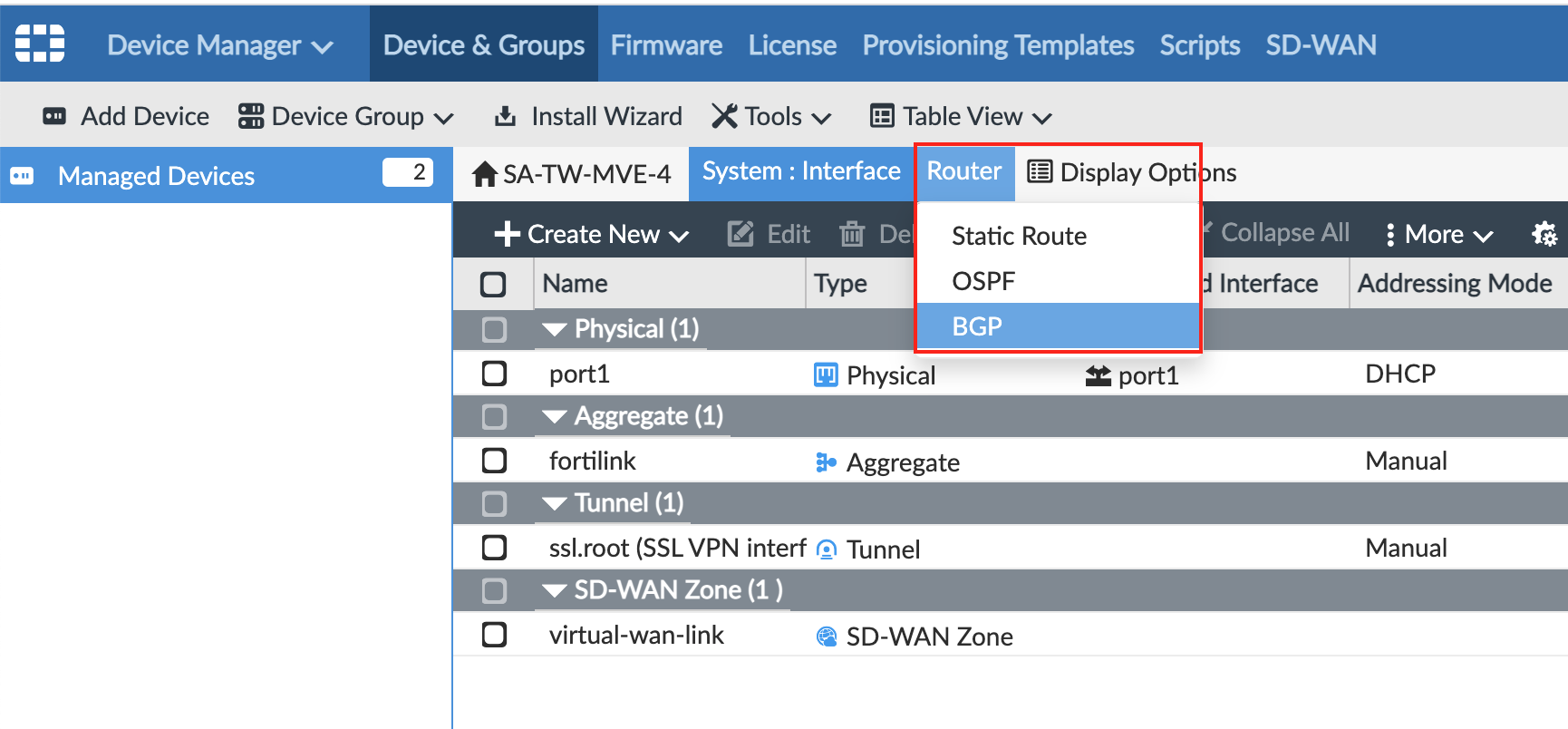
-
Provide this information:
- Local AS – Provide the ASN for the MVE connection. Specify the Peer ASN that you defined in the BGP configuration for the VLAN attachment in the Google Cloud console.
- Router ID – Specify the Cloud Router BGP IP from the VLAN attachment details in the Google Cloud console.
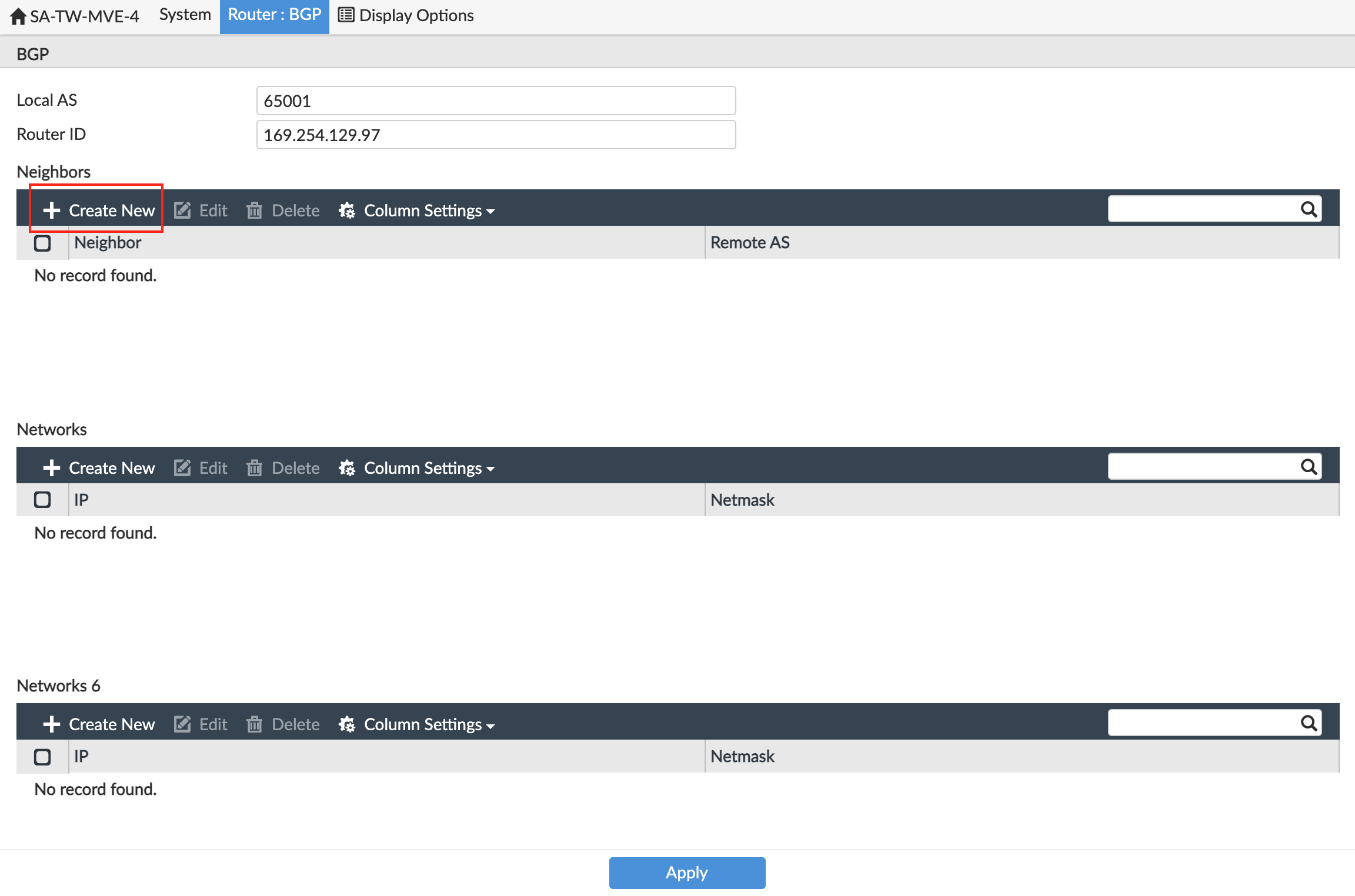
-
In Neighbors, click +Create New.
- For the neighbor IP, add the Cloud Router BGP IP from the VLAN attachment details in the Google Cloud console.
-
For Remote ASN, enter the Google Cloud ASN of 16550.
This is a fixed value, and appears in the connection details on the Google console. -
Click OK.
- Click Apply.
Note
Google Cloud requires BGP multihop support. You can configure multihop support from the Fortinet CLI with these commands:
config router bgp
config neighbor
edit "<neighbor ip>"
set ebgp-enforce-multihop enable
next
end
Validating your Google Cloud connection
You can review connection details, including the connection state, from the Fortinet CLI with these commands:
get system interface– Displays configuration details and current status for the device interfaces.get router info bgp neighbor <ip-address>– Displays configuration details and current status for the BGP neighbors.